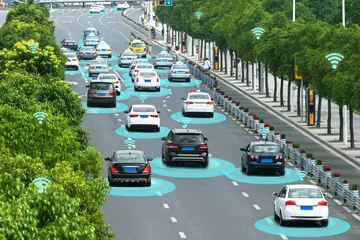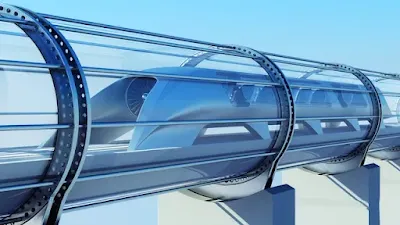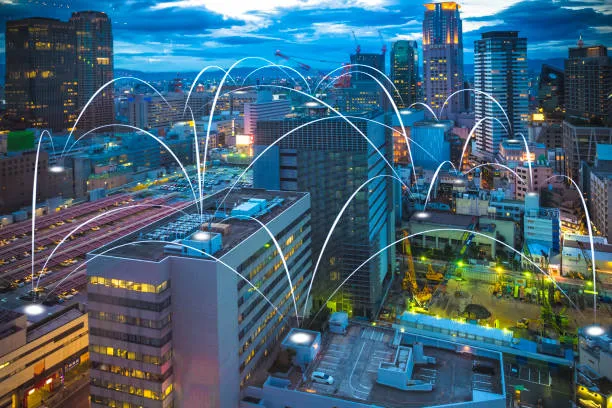As technology continues to advance, it has had a significant impact on various aspects of our lives, including transportation and mobility. From electric vehicles to hyperloops, new technologies have the potential to revolutionize the way we move around cities and beyond. As such, it is important to understand the effects of these technologies on transportation and mobility.
The aim of this article is to provide an overview of the various technologies that are transforming the transportation industry, their advantages and disadvantages, and their impact on transportation and mobility. Specifically, we will explore electric vehicles (EVs), autonomous vehicles (AVs), hyperloops, high-speed rail, sustainable transportation, smart cities, and mobility as a service (MaaS).
We will begin by discussing EVs, which have
gained popularity in recent years due to their potential to reduce carbon
emissions and improve air quality. Next, we will examine AVs, which have the
potential to reduce traffic accidents and congestion, and the challenges they
face in terms of regulations and public acceptance. We will also discuss the
futuristic technology of hyperloops and high-speed rail, which have the
potential to revolutionize long-distance travel.
Sustainable transportation, which encompasses
various modes of transportation that are environmentally friendly, will also be
explored. In addition, we will discuss smart cities and MaaS, which offer
integrated and convenient transportation solutions for urban areas. Lastly, we
will explore the challenges associated with implementing these technologies and
discuss future directions for transportation and mobility.
Overall, understanding the effects of technology on transportation and mobility is crucial in developing sustainable and efficient transportation systems that benefit both individuals and society as a whole.
Electric
Vehicles (EVs):
Electric vehicles (EVs) are automobiles that
are powered by electric motors, instead of traditional internal combustion
engines. EVs can be powered by electricity from various sources, including
batteries, fuel cells, or through a hybrid system that uses both electricity
and gasoline. EVs have gained popularity in recent years due to their potential
to reduce carbon emissions and improve air quality.
Definition and Types of EVs:
EVs come in various types, including battery electric vehicles (BEVs), plug-in hybrid electric vehicles (PHEVs), and hybrid electric vehicles (HEVs). BEVs rely solely on electric power stored in their batteries and require charging from an external power source. PHEVs have both an electric motor and a gasoline engine, and can be charged from an external power source, as well as fueled by gasoline. HEVs use both an electric motor and a gasoline engine, but unlike PHEVs, they cannot be charged externally and rely on regenerative braking to recharge their batteries.
Advantages and Disadvantages of EVs:
One major advantage of EVs is their potential
to reduce carbon emissions and improve air quality, particularly in urban
areas. EVs produce zero emissions while driving, unlike gasoline-powered
vehicles that emit carbon dioxide and other harmful pollutants. Additionally,
EVs can be charged from renewable energy sources, further reducing their carbon
footprint.
Another advantage of EVs is their low
operating costs. Electricity is generally cheaper than gasoline, and EVs
require less maintenance than gasoline-powered vehicles due to their simpler
engines and fewer moving parts. However, EVs can have higher upfront costs due
to the expense of the batteries and electric motors.
One major disadvantage of EVs is their limited driving range, which can make long-distance travel difficult without frequent charging. However, this is improving with the development of larger battery capacities and faster charging technologies. Additionally, charging infrastructure can be limited in some areas, making it difficult for EV owners to find charging stations.
Impact of EVs on Transportation and Mobility:
EVs have the potential to transform the transportation
industry by reducing carbon emissions, improving air quality, and reducing
dependence on fossil fuels. Governments and businesses around the world are
investing in EV technology, with many countries setting targets to phase out
gasoline-powered vehicles in the coming decades.
However, the adoption of EVs also poses
challenges, particularly in terms of infrastructure. To support widespread
adoption, charging infrastructure needs to be expanded and upgraded, and
charging times need to be reduced. Additionally, the cost of batteries needs to
be reduced to make EVs more affordable for the average consumer.
Future of EV Technology:
The future of EV technology looks promising,
with advancements in battery technology and charging infrastructure. Battery
capacities are increasing, reducing concerns about limited driving range, and
fast charging technologies are being developed that can charge EVs in a matter
of minutes. Additionally, governments and businesses are investing in charging
infrastructure, with plans to install thousands of charging stations in the
coming years.
Overall, EVs have the potential to significantly impact the transportation industry by reducing carbon emissions and improving air quality. While challenges remain, the future of EV technology looks promising, with continued investments and advancements in battery and charging technologies.
Autonomous
Vehicles (AVs):
Autonomous vehicles (AVs), also known as
self-driving cars, are vehicles that are capable of sensing their environment
and navigating without human input. AVs have the potential to reduce traffic
accidents and congestion, improve mobility for the elderly and disabled, and
reduce the cost of transportation. However, AV technology faces challenges in
terms of regulations and public acceptance.
Definition and Types of AVs:
AVs can be categorized into five levels based
on their autonomy, ranging from Level 0 (no automation) to Level 5 (full
automation). Level 1 and Level 2 vehicles have some automation, such as
adaptive cruise control and lane departure warning systems, but still require
human input. Level 3 vehicles are capable of driving autonomously in some situations,
but still require human intervention in certain circumstances. Level 4 vehicles
can operate autonomously in specific geographic areas or under certain
conditions, but may still require a human driver in certain situations. Level 5
vehicles are fully autonomous and can operate in any environment without human
input.
Advantages and Disadvantages of AVs:
One major advantage of AVs is their potential
to reduce traffic accidents and fatalities. Most traffic accidents are caused
by human error, such as distracted driving or drunk driving. AVs are capable of
sensing their environment and making split-second decisions, potentially
reducing the number of accidents on the road. AVs can also reduce traffic
congestion, as they are capable of communicating with other vehicles and
optimizing their routes.
However, there are also disadvantages to AV technology. One concern is the loss of jobs in the transportation industry, particularly for truck drivers and delivery drivers. AVs may also exacerbate existing social and economic disparities, as those who cannot afford AV technology may be left behind in terms of mobility options. Additionally, there are concerns about cybersecurity and the potential for AVs to be hacked.
Impact of AVs on Transportation and Mobility:
AVs have the potential to revolutionize the
transportation industry by reducing traffic accidents, improving mobility for
the elderly and disabled, and reducing the cost of transportation. AVs can also
reduce the need for parking spaces, as they can drop off passengers and then
park themselves in designated areas. Additionally, AVs can reduce the need for
personal car ownership, as individuals can subscribe to a transportation
service that provides AVs on demand.
However, the adoption of AVs also poses
challenges, particularly in terms of regulations and public acceptance. AV
technology is still relatively new, and regulations governing their use are
still being developed. Additionally, public acceptance of AVs is still low,
with many individuals expressing concerns about the safety and reliability of
the technology.
Future of AV Technology:
The future of AV technology looks promising,
with continued investments in research and development. However, challenges
remain in terms of regulations and public acceptance. To promote widespread
adoption of AVs, regulations need to be developed that ensure the safety and
reliability of the technology. Additionally, public education campaigns can
help increase awareness and understanding of AV technology.
Overall, AVs have the potential to significantly impact the transportation industry by reducing traffic accidents and congestion, improving mobility options for the elderly and disabled, and reducing the cost of transportation. However, challenges remain in terms of regulations and public acceptance, and continued investment and research is needed to fully realize the potential of AV technology.
Hyperloops
and High-Speed Rail:
Hyperloops and high-speed rail are two
emerging technologies that have the potential to revolutionize transportation
by providing faster, more efficient, and more sustainable options for
long-distance travel. Both technologies face challenges in terms of funding and
public acceptance, but have the potential to significantly impact
transportation in the future.
Hyperloops:
Hyperloops are a type of transportation system
that uses vacuum-sealed tubes to transport passengers or cargo at high speeds.
The concept was first proposed by entrepreneur Elon Musk in 2013, and has since
garnered interest from various companies and governments.
Hyperloops have the potential to provide
faster and more efficient long-distance travel, as they can reach speeds of up
to 700 miles per hour. They also have the potential to be more sustainable than
traditional modes of transportation, as they can be powered by renewable energy
sources.
However, hyperloops face challenges in terms of funding and public acceptance. The technology is still in the early stages of development, and the cost of building a hyperloop system is high. Additionally, there are concerns about the safety and reliability of the technology, as well as the potential impact on local communities.
High-Speed Rail:
High-speed rail is a mode of transportation
that uses specially designed trains to travel at speeds of up to 186 miles per
hour or more. High-speed rail is already in use in several countries, including
Japan, China, and France, and has been proposed in other countries such as the
United States.
High-speed rail has the potential to provide
faster and more efficient long-distance travel, reducing travel time and
increasing mobility options. High-speed rail can also be more sustainable than
other modes of transportation, as it emits less greenhouse gases than airplanes
or cars.
However, high-speed rail also faces challenges
in terms of funding and public acceptance. The cost of building a high-speed
rail system is high, and there may be opposition from local communities
affected by the construction of the rail line. Additionally, high-speed rail
may not be practical in areas with low population density or where existing
transportation options are already in place.
Impact of Hyperloops and High-Speed Rail on Transportation
and Mobility:
Both hyperloops and high-speed rail have the potential to significantly impact transportation and mobility by providing faster and more efficient options for long-distance travel. Hyperloops in particular could transform the way people and goods are transported, potentially reducing travel time and increasing mobility options for individuals and businesses.
However, the adoption of these technologies
also poses challenges. Hyperloops and high-speed rail require significant
investment in infrastructure and technology, and public acceptance may be low
due to concerns about safety, reliability, and impact on local communities.
Future of Hyperloop and High-Speed Rail
Technology:
The future of hyperloop and high-speed rail
technology is promising, with continued investment and research being made in
both areas. However, challenges remain in terms of funding, regulations, and
public acceptance. To promote widespread adoption of these technologies,
governments and private companies will need to work together to address these
challenges and ensure the safety, reliability, and sustainability of hyperloop
and high-speed rail systems.
Overall, hyperloops and high-speed rail have the potential to significantly impact transportation and mobility by providing faster, more efficient, and more sustainable options for long-distance travel. However, challenges remain in terms of funding, regulations, and public acceptance, and continued investment and research is needed to fully realize the potential of these technologies.
Sustainable
Transportation:
As concerns about climate change and
environmental sustainability continue to grow, sustainable transportation has
become an increasingly important topic of discussion. Sustainable
transportation refers to modes of transportation that are designed to minimize
their impact on the environment and promote the use of renewable energy
sources.
Electric Vehicles (EVs):
Electric vehicles (EVs) are one of the most well-known examples of sustainable transportation. By using electricity as their primary fuel source, EVs emit fewer greenhouse gases than traditional gasoline-powered vehicles. EVs are becoming increasingly popular, with major automakers such as Tesla, Nissan, and General Motors investing in EV technology.
While EVs offer a more sustainable mode of
transportation, there are still challenges that must be addressed. The range of
EVs is still limited compared to traditional vehicles, and the infrastructure
for charging EVs is still developing. Additionally, the production and disposal
of batteries used in EVs can have significant environmental impacts.
Public Transportation:
Public transportation, such as buses and
trains, can also be a more sustainable mode of transportation. Public
transportation can reduce the number of cars on the road, which can decrease
traffic congestion and emissions. Additionally, public transportation can be
designed to use renewable energy sources such as electricity or biofuels.
However, public transportation also faces
challenges in terms of funding and public acceptance. Many cities struggle to
maintain and expand public transportation systems due to limited funding and
political opposition. Additionally, some individuals may be hesitant to use
public transportation due to concerns about safety or convenience.
Bicycles and Pedestrian Infrastructure:
Bicycles and pedestrian infrastructure can also play a role in promoting sustainable transportation. By providing safe and convenient options for biking and walking, cities can reduce the number of cars on the road and promote healthy, active lifestyles.
However, there are challenges to promoting
bicycle and pedestrian infrastructure. Many cities lack the necessary
infrastructure to support biking and walking, such as bike lanes and sidewalks.
Additionally, there may be opposition from drivers or businesses that see the
infrastructure as a hindrance to their activities.
Future of Sustainable Transportation:
The future of sustainable transportation is
promising, with continued investment and research being made in electric
vehicles, public transportation, and bicycle and pedestrian infrastructure.
However, challenges remain in terms of funding, regulations, and public
acceptance.
To fully realize the potential of sustainable
transportation, governments and private companies will need to work together to
address these challenges and promote the use of sustainable transportation
options. This will require continued investment in research and development, as
well as policies and regulations that promote the use of sustainable transportation
options. By doing so, we can create a more sustainable future for
transportation and mobility.
Overall, sustainable transportation is an important topic in today's world, as we strive to reduce our impact on the environment and promote a healthier, more sustainable future. By promoting the use of electric vehicles, public transportation, and bicycle and pedestrian infrastructure, we can create a more sustainable future for transportation and mobility.
Smart
Cities and Mobility as a Service (MaaS):
As technology continues to advance, the concept of smart cities and Mobility as a Service (MaaS) is becoming increasingly popular. Smart cities are cities that use technology to improve efficiency, sustainability, and livability. MaaS is a concept that aims to provide seamless transportation options through a single platform.
Smart Cities:
Smart cities use technology to improve transportation and mobility in a number of ways. For example, smart traffic systems can reduce congestion by adjusting traffic signals based on real-time traffic data. Smart parking systems can help drivers find available parking spots, reducing the time spent circling around for a spot and the emissions that come from idling.
Smart cities can also use data analytics to
improve public transportation systems. For example, analyzing ridership data
can help public transportation systems adjust their routes and schedules to
better meet the needs of riders. Smart cities can also use data to optimize the
use of shared mobility services such as bike-sharing or car-sharing programs.
Mobility as a Service (MaaS):
Mobility as a Service (MaaS) is a concept that
aims to provide seamless transportation options through a single platform. The
idea is that users can access a variety of transportation modes such as public
transportation, ride-sharing, bike-sharing, and car-sharing through a single
app or platform.
MaaS has the potential to revolutionize transportation and mobility by making it easier for users to choose the most efficient and sustainable mode of transportation for their needs. By providing users with real-time information on transportation options and pricing, MaaS can reduce the need for personal vehicles and promote the use of shared mobility services.
However, there are challenges to implementing
MaaS. For example, integrating different transportation modes into a single
platform can be complex, as each mode has its own pricing, scheduling, and
reservation system. Additionally, there may be concerns about data privacy and
security when using a single platform for multiple transportation modes.
Future of Smart Cities and MaaS:
The future of smart cities and MaaS is
promising, with continued investment and research being made in both areas. By
using technology to improve transportation and mobility, we can reduce
congestion, emissions, and improve the overall livability of our cities.
To fully realize the potential of smart cities
and MaaS, governments and private companies will need to work together to
address the challenges and promote the use of these technologies. This will
require continued investment in research and development, as well as policies
and regulations that promote the use of these technologies.
Overall, smart cities and MaaS are promising technologies that have the potential to revolutionize transportation and mobility. By using technology to improve transportation options, we can create a more sustainable, efficient, and livable future for our cities.
Challenges
and Future Directions:
While technology has made great strides in
improving transportation and mobility, there are still challenges that need to
be addressed. Here are some of the challenges that exist and possible future
directions for addressing them:
Infrastructure:
One of the biggest challenges facing transportation and mobility is infrastructure. As electric and autonomous vehicles become more prevalent, there will need to be significant investments in charging stations and roadway infrastructure to support them. Additionally, there may be challenges in integrating these new modes of transportation with existing infrastructure, particularly in older cities with limited space for new infrastructure.
Future directions: Governments and private
companies will need to work together to invest in infrastructure that can
support the transportation technologies of the future. This may require
significant funding and policy changes to encourage private investment.
Regulations:
Another challenge facing transportation and
mobility is regulations. As new technologies emerge, regulations will need to
be updated to ensure their safe and effective use. Additionally, there may be
regulatory challenges in integrating different modes of transportation into a
single platform, such as with Mobility as a Service (MaaS).
Future directions: Governments and regulatory bodies will need to work with technology companies and transportation providers to develop regulations that encourage innovation while ensuring safety and effectiveness.
Equity:
Transportation and mobility have the potential
to significantly impact equity in society. For example, the cost of electric
and autonomous vehicles may be prohibitive for many individuals and
communities. Additionally, the implementation of new transportation
technologies may impact low-income neighborhoods differently than affluent
neighborhoods.
Future directions: Governments and transportation providers will need to work to ensure that new transportation technologies are accessible and affordable for all individuals and communities. This may require the development of subsidies or other incentives to promote the use of sustainable and equitable transportation options.
Public Perception:
Finally, public perception can also be a
challenge for transportation and mobility technologies. For example, there may
be concerns about the safety and reliability of autonomous vehicles.
Additionally, some individuals may be resistant to using shared mobility
services, such as ride-sharing or bike-sharing programs.
Future directions: Governments and technology
companies will need to work to address public concerns and increase awareness
and education about the benefits of new transportation technologies.
Overall, while there are challenges facing transportation and mobility, there are also promising future directions for addressing these challenges. By investing in infrastructure, updating regulations, promoting equity, and addressing public concerns, we can create a more sustainable, efficient, and equitable future for transportation and mobility.
Conclusion:
In conclusion, technology has been
transforming the way we think about transportation and mobility. From electric
vehicles to hyperloops, innovative solutions are being developed to address the
challenges of modern transportation. EVs are already reducing emissions and
lowering the cost of transportation, while AVs have the potential to make
driving safer and more efficient. Hyperloops and high-speed rail could
revolutionize long-distance travel, making it faster, cheaper, and more
sustainable. However, these technologies also present new challenges, such as
cybersecurity risks and the need for infrastructure improvements.
To fully realize the potential of technology in transportation, sustainable solutions are needed. Sustainable transportation aims to reduce the environmental impact of transportation while also improving access and equity. Smart cities and MaaS can play an important role in achieving sustainable transportation, by using data and technology to optimize the use of existing infrastructure and services.
Looking
to the future, there is no doubt that technology will continue to transform
transportation and mobility. However, it is important to consider the potential
impacts of these technologies, and ensure that they are developed and deployed
in a way that promotes sustainability, safety, and equity. By working together,
industry, government, and the public can create a transportation system that
meets the needs of everyone, while also protecting our planet and our
communities.














0 Comments